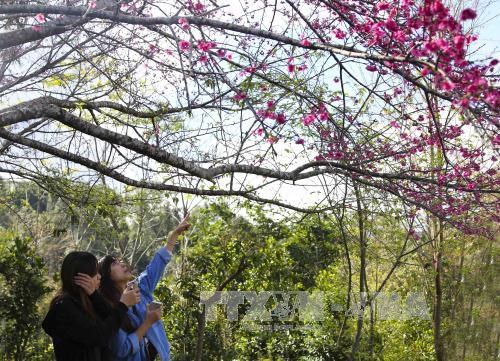
The cherry blossom festival will return to Pa Khoang commune, Dien Bien district, the northwestern province of Dien Bien for the second time from January 11 – 13, 2019.

Visitors enjoy cherry blossom in Pa Khoang, Dien Bien. (Photo:
VNA)
A series of cultural events will be held during the festival which
was launched in 2018 to lure more visitors to Hoa Island in Pa Khoang commune
to enjoy beautiful cherry blossom. They will include an exhibition of local
distinctive culture, community activities and folk games of mountain tribes,
agricultural market of the ethnic locals and a space for displaying traditional
cuisine of the northwestern region.
Visitors to the festival will also have a chance to explore Japanese tea
ceremony, Japanese rice wine Sake and Mong Pe, an aromatic wine of Vietnam’s
northwestern region distilled from maize fermented with a special forest
leaves.
The People’s Committee of Dien Bien district, the organizer of the festival,
expects that the number of cherry trees in full bloom at the time when the
festival takes place will triple that of this year.
The festival is intended to promote the beauty of people and nature of Dien
Bien and foster the development of Pa Khoang – Muong Phang tourism complex as
the province sets to make Hoa Island a popular destination. Visitors to the
island during the festival will be offered free admission.
It also serves as a curtain raiser for the celebration of the 65th year of Dien
Bien Phu Victory and 110th founding anniversary of the province.
Residents of Dien Bien district refer to Hoa Island, which sits in the middle
of the district’s pristine Pa Khoang Lake, "the island of cherry blossom”.
There are about 1,000 cherry trees on the island, which bloom brilliantly
during spring (January to April). The trees, imported from Japan and grown
locally, are called "higan sakura” with "higan” a reference to a
spring Buddhist holiday celebrated by Japanese.
They were nurtured by Dr Tran Le, a Vietnamese scientist who specialises in
plant tissue culture. Le spent months wandering the country to find a suitable
place for the trees, after a Japanese friend had given him the seeds.
He found the island in 2006, where he successfully planted them. Out of the 10
initial seeds, eight survived and after eight years a large part of the
600ha-island is covered with "sakura” petals during spring.
The beautiful cherry blossom started attracting visitors in recent years.
Besides the trees, a large collection of exotic plants and flowers are gathered
from across the country on the island.
Source: VNA
With an increasingly vibrant and widespread emulation movement aimed at building cultured residential areas and cultured families, Yen Thuy District has been making steady progress toward improving both the material and spiritual well-being of its people, while fostering a civilized, prosperous, beautiful, and progressive community.
Once lacking recreational spaces and community facilities, Residential Group 2 in Quynh Lam Ward (Hoa Binh City) has recently received attention for the construction of a new, spacious, and fully equipped cultural house. The project followed the model of state support combined with public contributions in both labor and funding.
The "All people unite to build cultural life" movement, which has been effectively integrated with Kim Boi district’s socio-economic development goals, is fostering a lively spirit of emulation across local residential areas, hamlets, villages, public agencies, and enterprises. In addition, through the initiative, traditional cultural values are being preserved and promoted, while community solidarity and mutual support in poverty reduction and economic development are being strengthened.
A working delegation of the Hoa Binh provincial People’s Committee led by its Permanent Vice Chairman Nguyen Van Toan on June 11 inspected the progress of a project to build the Mo Muong Cultural Heritage Conservation Space linked to tourism services in Hop Phong commune, Cao Phong district.
Born and growing in the heroic land of Muong Dong, Dinh Thi Kieu Dung, a resident in Bo town of Kim Boi district, in her childhood was nurtured by the sweet lullabies of her grandmother and mother. These melodies deeply imprinted on her soul, becoming an inseparable part of her love for her ethnic group's culture. For over 20 years, this love for her hometown has driven Dung to research, collect, and pass down the cultural values of the Muong people to future generations.
In the final days of May, the Ethnic Art Troupe of Hoa Binh Province organized performances to serve the people in remote, mountainous, and particularly disadvantaged areas within the province. These were not just ordinary artistic shows, but they were the meaningful journeys aimed at spreading cultural values, enhancing the spiritual life of the people and contributing to the preservation of ethnic minority cultural identities.



